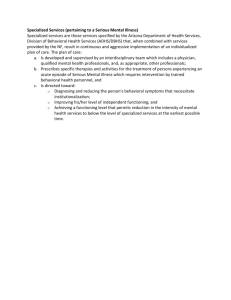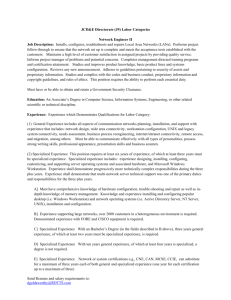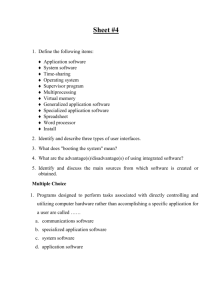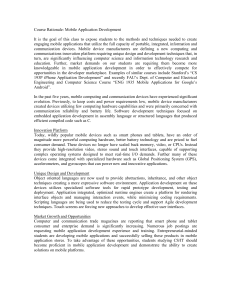SNSC Business Plan
advertisement
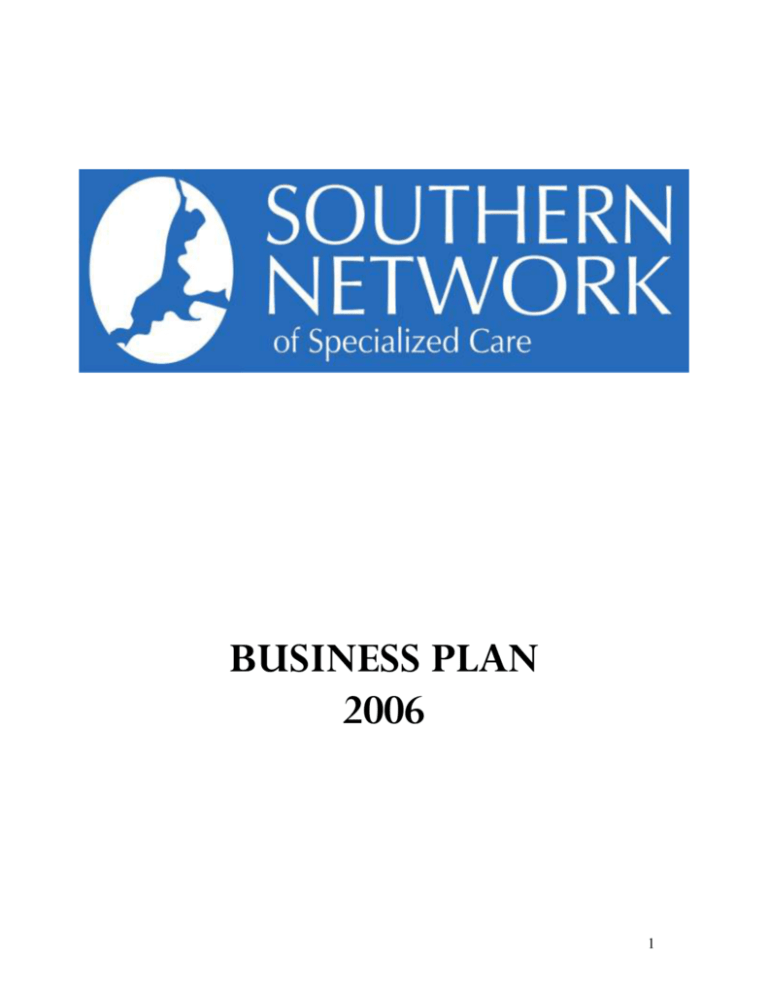
BUSINESS PLAN 2006 1 Members Joint Implementation Team Ministry of Community and Social Services Southwest Region and Hamilton Niagara Region As co-leads of the Network, it is with great pleasure that we present to you as representatives of the Ministry of Community and Social Services the first business plan of the Southern Network of Specialized Care. This business plan will help form the work and future direction of the Planning and Coordination Network, whose work will be to identify changing needs; gaps and barriers to services; and identify the need for specialized services providers to meet the service plans for adults with an intellectual disability with specialized needs. One of the first tasks of the Planning and Coordination Network will be to review and have input into the vision and mission statements of the Southern Network. We view our work as truly a collaborative and coordinating effort within the Southern Network. As the Network begins to emerge and develop its work, we have been encouraged by the positive responses we have received in communities throughout the Southern Network Region. We have encouraged the communities within the Southern Network to contact us with their input, knowledge, concerns and questions. We believe that the strength of the Network depends on all of us working as a Regional team to provide the best quality of services to adults with intellectual disabilities and their families. Respectfully Submitted By, Glen Walker Co-Lead Southern Network of Specialized Care Brian Davies Co-Lead Southern Network of Specialized Care 2 Southern Network of Specialized Care Business Plan Table of Contents Southern Network of Specialized Care ....................................................................... 3 INTRODUCTION .............................................................................................................. 5 STRATEGIC VISION ........................................................................................................ 5 MISSION STATEMENT ................................................................................................... 5 GOALS ............................................................................................................................... 6 ESTABLISH A TWO TIER SOUTHERN COMMUNITY NETWORK OF SPECIALIZED CARE (SOUTHERN NETWORK).......................................................... 7 GOVERNANCE MODEL .................................................................................................. 7 FIRST TIER: LOCAL SERVICE DELIVERY NETWORK ............................................. 8 MEMBERSHIP OF THE LOCAL SERVICE DELIVERY NETWORK .......................... 9 SERVICE IN THE PERSON’S HOME (WITHIN FAMILY OR AGENCY HOME)URGENT RESPONSE ....................................................................................................... 9 CREATING A SAFE PLACE IN THE COMMUNITY .................................................... 9 SHORT TERM TREATMENT SPACE........................................................................... 10 LSDN ANIMATORS ....................................................................................................... 10 SECOND TIER: PLANNING AND COORDINATING NETWORK ............................ 10 MEMBERSHIP................................................................................................................. 11 THIRD TIER: CORPORATE MINISTRY NETWORK ................................................. 11 CONNECTING THE NETWORKS AND PLANNING GROUPS ................................. 12 DESIRED OUTCOMES ................................................................................................... 12 WORK PLAN ................................................................................................................... 14 Performance Measures Goal 1 ......................................................................................... 14 Performance Measures Goal 2 ......................................................................................... 16 Performance Measures Goal 3 .......................................................................................... 18 Performance Measures Goal 4 .......................................................................................... 19 Performance Measures Goal 5 ......................................................................................... 20 Performance Measures Goal 6 ......................................................................................... 21 Performance Measures Goal 7 ......................................................................................... 22 EVALUATION PROCESS .............................................................................................. 23 3 4 BUSINESS PLAN FOR THE SOUTHERN NETWORK OF SPECIALIZED CARE INTRODUCTION The business plan of the Southern Network of Specialized Care is intended to provide the goals and strategic vision for the creation and maintenance a community network of care for providing specialized services to people with a developmental disability and a coexisting mental health or behavioural problems. The report is divided into two sections. The first section provides the business plan and the second part the background material upon which the plan is based. In order to respond to the challenges identified in the Environmental Scan and the Regional Solutions Report, Ministry of Community and Social Services (MCSS) in the Southwest and Hamilton/Niagara Regions is creating the Southern Community Network of Specialized Care. The Network is expected to create and maintain the ability to respond to the specialized needs of adults with a developmental disability and coexisting mental health or behavioural challenges; promote a regional system of specialized resources to meet the specialized needs of these people; recruit and retain the services of qualified professionals, integrate evidence-based practice into the service delivery system, and create and maintain specialized assessment and treatment spaces within the southern area. Regional Support Associates (RSA) and Bethesda will act as the lead organizations for the development and management of the Network in the Southern area. They will act jointly and separately in providing leadership and services in meeting the goals of the Network. The Co-Lead agencies will be accountable for the resources provided by MCSS for the network. They will be held responsible for achieving the goals and objectives set out in this business plan. STRATEGIC VISION People with developmental disabilities and co-existing mental health issues and/or challenging behaviours will live in their communities as full citizens. They will enjoy an accessible, fair and sustained developmental service system in the Southern Region. MISSION STATEMENT The Southern Network of Specialized Care creates a unified network of specialized services and clinicians that can offer individuals with a developmental disability and their families the highest quality of assessment, treatment and training. The network links clinical specialists through research, and training, in their quest to continuously improve practice and knowledge in the field. The network provides a 5 unified voice for specialized services through participation in local, regional and provincial forums. It seeks to attract professionals to the field and retain those skilled individuals who have dedicated their careers to serving individuals with a developmental disability. GOALS Goals of the Southern Community Network of Specialized Care: 1. To establish the Southern Network of Specialized Care including the Planning and Coordinating Network and the Local Service Delivery Networks. 2. To create a more unified service delivery system able to meet the (specialized) needs of adults with developmental disabilities and coexisting mental health and behavioural challenges including connecting with the other three networks. 3. To increase the ability of the service delivery system to respond to the urgent needs of adults with a developmental disability and coexisting mental health and behavioural challenges. 4. To improve access to the system of specialized clinical services, supports and resources. 5. To monitor and make recommendations as appropriate regarding the need for a variety of transitional supports, clinical services, consultation, coordinated access to services, specialized accommodations and case management of complex situations. 6. To identify research needs and priorities, link organizations engaged in research and promote the use of evidence-based practices. 7. To expand recruitment, retention and involvement of specialized staff within the field of developmental services for people with high needs. The achievement of these goals is mutually reinforcing. In order to achieve these goals the Southern Community Network of Specialized Care will establish a two-tier community network made up of a Planning and Coordinating Committee and Local Service Delivery Networks. 6 ESTABLISH A TWO TIER SOUTHERN COMMUNITY NETWORK OF SPECIALIZED CARE (SOUTHERN NETWORK) Meeting the needs of persons with specialized needs is a joint effort between caregivers (families and agencies) and specialized service providers. The Southern Network needs to attend to both the provision of services for persons with specialized needs and the planning and coordinating of specialized services. The two tier Southern Network will ensure a systematic approach to the resolution of systems problems. The model builds on the capacity of existing services and structures in supporting adults with specialized needs including these Dual Diagnosis services funded by Ministry of Health and Long Term Care (MOHLTC). As well, it places responsibility for providing, managing and developing support and services at appropriate levels. The first Southern Network tier is responsible for creating stable conditions for adults with high needs, linking specialized supports with local crisis and urgent responses when they happen and creating the conditions necessary for delivering specialized services effectively. The second Network tier is responsible for planning and coordinating the delivery of these services in communities across the entire Southern region. GOVERNANCE MODEL The Southern Network will create a Planning and Coordinating Network with members on the second tier who will provide advice to the network co-leads regarding the vision, direction; strategic objectives and business plan for the operation of the network. The Planning and Coordinating Network members on the second tier, with input from the Local Service Delivery Networks of the Southern Network will describe the outcomes expected from the local networks. They will describe the parameters in which the outcomes will be expected to be delivered. The Planning and Coordinating Network will be at liberty to form a range of sub-groups to deal with particular issues, extend the reach of the network to other agencies or committees, and receive advice and support from other community groups as necessary. A list of membership is included in the working notes of the business plan. The Local Service Delivery Network will focus on more specific individual needs and foster local linkages within the community. This will include connecting with specialized service providers to meet the unique needs of individuals with specialized needs within their communities. The goal is to have the Local Service Delivery Network (tier one) develop the methods for achieving the outcomes expected by the Planning and Coordinating Network (tier two committee). The membership of the Local Service Delivery Network will be finalized through the community consultation process currently under way. The process will guide the finalization of the roles, or fit with existing community committees, type of representatives they need or how to be represented in other local forums, how they are selected, their term, decision-making process, and the exact number of representatives. The Co-Lead agencies will take advice from the PCN and will be responsible for achieving the goals and objectives as set out in the business plan. They will be 7 responsible for budgeting the resources of the Network and will be accountable to the funder for the utilization of those resources. The Ministry of Community and Social Services will participate in the process through a non-voting membership on the PCN tier two network group. They will also continue to support the process through a Joint Implementation Team linking the South West and Hamilton Niagara Regional offices together with the network leads. The Ministry of Community and Social Services will also monitor activity of the network through their contractual agreements with the network leads. FIRST TIER: LOCAL SERVICE DELIVERY NETWORK Roles and Activities A Local Service Delivery Network (tier one) will be developed at the local level. This approach builds on local capacity to support adults with developmental disabilities and co-existing mental health and/or behavioural challenges. The Local Service Delivery Network brings together local agencies and caregivers so that they may continually review the needs of adults with specialized needs and develop coordinated ways of addressing emerging issues. In addition to providing services to adults with more complex needs the Network should also be responsible for: Identifying adults with specialized needs and ensuring adequate assessment Creating connections between adults with specialized needs and local specialized resources Developing community based service plans for adults with more complex needs Link into or develop a local crisis and urgent response mechanism for adults with specialized needs Developing specialized support models with new and existing resources to more adequately meet the needs of individuals in their own community Identifying local training needs regarding issues related to adults with specialized needs. Identifying emerging gaps and barriers to services Communicating with the Planning and Coordinating Network Implementing elements in the Networks business plan and strategic objectives which relate to the local community It is expected that there could be up to 14 Local Service Delivery Networks. The membership of the local network will include representatives from the DS agencies, and access/contact agencies, mental health agencies, family physicians, police, or other community agencies where appropriate. Existing structures of committees could be used if the mandate or part of that mandate can be altered to include these specialized network functions. These groups will be formed in upcoming months facilitated by local MCSS staff and network leads. 8 MEMBERSHIP OF THE LOCAL SERVICE DELIVERY NETWORK Local DS agencies, access/contact agency, representation from families, local mental health, police and other community agencies as needed. Each Local Service Delivery Network would include a small number of members and membership would depend upon existing relationships. Membership could include local DS agencies, representatives from the mental health sector, and possibly police or other service agencies as needed. Similar to the wraparound process, the Network should place the person at the center of their concerns, and include as participants the caregiver and/or family members. Where possible, the Network should include specialized clinicians to help in providing effective interventions. The Local Service Delivery Networks will be expected to establish the following processes for supporting adults with developmental disabilities and specialized needs. SERVICE IN THE PERSON’S HOME (WITHIN FAMILY OR AGENCY HOME)- URGENT RESPONSE When the person with specialized needs is manifesting actions and behaviours that are threatening to others or so disruptive that caregivers can no longer manage the situation an urgent response will be made. If providers are involved in offering enhanced preventive supports the response could be made to avoid the individual leaving their home and averting the escalation of the situation into a crisis. The purpose of the response is to stabilize the situation so that the person may stay within their own home. It may take the form of rapid assessment for the individual and their situation, provision of specialized services, in home support, and training for caregivers in how to deal with ongoing challenges. The model will be based on the circle of support or wrap around process used in children’s services. This service will be provided by trained staff members of the local DS agency and be coordinated by the Local Service Delivery Network. The worker will be linked to and supported by specialized service providers to ensure that effective and the least intrusive supports are provided to the individual and their support system. CREATING A SAFE PLACE IN THE COMMUNITY If the individual’s situation becomes unsafe and there is imminent risk to the individual through self injury or for others due to aggression the person will need to leave their present living arrangements for a short period of time and have access to a ‘safe space’. This safe place or short-term supportive environment will be located within a DS agency or similar facility within the local community. 9 The purpose of removing the individual from their environment is to provide an opportunity to change the environment, to work with the family or staff, and to provide therapeutic support to the person. This will prepare the individual to return to their home or a new and more appropriate place to live. Specially trained staff from the DS agency will support the person in the “safe place” with intensive support from specialized services. SHORT TERM TREATMENT SPACE Where it is indicated that an intensive longer-term treatment plan is required that cannot be met in the individual’s home environment, a treatment response is indicated. It is viewed that these environments will focus on the treatment needs with a view to repatriation to the individual’s home within several months. Operating funds will be attached to these supports, again on a flexible fiscal basis. LSDN ANIMATORS A community Animator/Specialized Service Facilitator will support each Service Delivery Network. The Animators/local specialized service facilitators will respond to the Local Service Delivery Network, but will be hired by and report to a developmental service agency. The role of the Animator is to support the local service network, bring together the resources that are needed to meet the needs of adults with specialized needs, help coordinate the use of the safe places and short term treatment spaces and provide limited case coordination functions To provide the most effective use of resources and to promote the intent of the initiative, ensuring most funds are used for direct support, it has been determined that animators will be shared among neighbouring counties. Each county may have its own LSDN, or they may choose to collaborate in this process using a singular LSDN. In those communities where there are groups already in place to address the functions as outlined, MCSS would promote their ongoing role. The animator will be employed by the lead agency but act on behalf of the LSDN’s. Protocols and expectations will need to be developed among partnering communities and the host agency to ensure equitable access and expectation of the animator prior to hiring. SECOND TIER: PLANNING AND COORDINATING NETWORK A Planning and Coordinating Network would be developed across the two MCSS regions. The Network would be responsible for ensuring that the Local Service Delivery Networks have access to the specialized services they need to achieve their goals. The Planning and Coordinating Network would also be responsible for: Identifying changing needs across the communities. Identifying cross community gaps and barriers to service 10 Identifying the need for specialized services that span more than one region Ensuring the capacity of the specialized service providers to meet the service plans for individuals with specialized needs Identifying possible duplication of services Coordinating the delivery of specialized services across the Local Service Delivery Networks Collaborating with community colleges and universities to develop student placements and educational opportunities in addition to partnering on research projects and guiding curriculum development Support training programs and professional development opportunities to enhance the ability of regulated health professionals and developmental services workers to support adults with specialized needs Developing community information programs to increase the general understanding of professionals, other community agencies and the public regarding the needs of adults with a specialized needs Link with other networks and government agencies on issues relating to specialized services Advise network leads annually on the creation of business plans to address the needs of individuals with specialized needs Evaluate the effectiveness of the network and its activities MEMBERSHIP In order to ensure accountability to the funders, representatives will provide the leadership for the Network from the Developmental Sector. It is recognized that the developmental sector alone cannot independently create the network. It will need to bridge connections with many other Ministries and agencies not funded or providing service exclusively to this population. The champions needed to lead this process will be drawn from the Developmental Sector due to their primary focus on this population and existing links into other sectors. The Network leads will hire a Coordinator of the Network. This will be a new full-time position that will report to the lead agencies but respond to the PCN in a facilitation and support role. Other staff will be recruited to take on special roles in the network where necessary. These tasks will include video network coordination and administrative support. THIRD TIER: CORPORATE MINISTRY NETWORK Corporate policy, program and funding should be discussed at the Corporate level between Ministries of Community and Social Services, Health, Corrections and Education. These ministries will need to be advised on these specialized services. The Network Leads will partner with their counter parts across the province to take on this valuable role. The Networks lead group will also work collaboratively on a variety of 11 activities such as a common web site, branding of the networks, video networking, research, staff retention and other topics of mutual interest. CONNECTING THE NETWORKS AND PLANNING GROUPS The Community Network of Specialized Care Co-ordinator for the Southern Network will be responsible for convening meetings of all Local Service Delivery Network Animators, likely twice each year. The Co-ordinator of the network will act as a resource to the Animators and will offer training and ongoing support. The Co-ordinator will assist local networks to implement their local plans and to operationalize second tier and provincially mandated initiatives. The purpose for these sessions and ongoing Co-ordinator contact is to gain from the Local Service Delivery Network perspective a report on trends, issues, gaps and priorities for investment, as it relates to specialized services, to inform the CNSC, as that group develops the work plan to respond to the Local Service Delivery Network perspective. This venue will also be a forum to share experience and best practice as the system continues to evolve and learn from each other. These regular meetings and contact with the Co-ordinator will, of course, also provide the plan, developed by the CNSC, in response to the Local Service Delivery Network’s concerns. The Local Service Delivery Networks may be established as a sub group of each local community planning group for developmental services. The community will determine the specific structure but the expectation is a clear communication linkage to the broader developmental services system through this process. At a provincial level, the co-leads of the Southern Network will connect with their counter-parts in the other three Networks, and work on issues related to research, best practice, and staff recruitment and retention. Another important aspect of this coordination provincially is the use of video conferencing to promote and achieve these provincial goals. DESIRED OUTCOMES In order to respond to these challenges MCSS in the Southwest and Hamilton/Niagara Regions is creating the Southern Community Network of Specialized Care. The Network is expected to create and maintain the ability to respond to the urgent needs of adults with a developmental disability and coexisting mental health or behavioural challenges; promote a regional system of specialized resources to meet the specialized needs of these people; recruit and retain the services of qualified professionals, integrate evidence-based practice into the service delivery system, and create and maintain 28 specialized accommodation spaces across the province. Regional Support Associates (RSA) and Bethesda Services will act as the lead organizations for the development and management of the Network in the Southern area. They will act jointly and separately in providing leadership and services in meeting the 12 goals of the Network. The Co-Lead agencies will BE responsible for funding provided by MCSS. They will be held responsible for achieving the goals and objectives set out in the contract (these should be the same set of goals and objectives as advised by the Planning and Coordination Network the planning arm of the Southern Community Network of Specialized Care) A visual representation of the structure of the network is presented below. It details how these three levels of the network will link and describes their roles and membership. Southern Network of Specialized Care The Community (I Service Delivery Network Responsible for providing services to people with high needs. (Dual Diagnosis) Creating connections between people with dual diagnosis and local resources. Identifying people with dual diagnosis and ensuring adequate assessment. Developing community based service plans for people with high needs. Developing a local crisis response for people with high needs. Identifying local training needs regarding issues related to people with dual diagnosis. Identifying emerging gaps and barriers to services. Communicating with the Planning and Coordinating Network. Membership: local DS Agencies, Access/Contact agency, reps from families, local mental health, police, and other community agencies as needed. Planning and Coordinating Network Responsible for ensuring that Service Delivery Networks have specialized services to achieve their goals. Identifying changing needs across the communities. Ensuring the capacity of the specialized service providers to meet the service plans for individuals with dual diagnosis. Coordinating the delivery of specialized services across the Service Delivery Networks. Collaborating with community colleges and universities to develop student placements and educational opportunities. Developing training programs and professional development opportunities to enhance the ability of developmental services worker to support people with dual diagnosis. Developing community information programs to increase the general understanding of professionals, other community agencies and the public regarding the needs of people with dial diagnosis. Identifying cross community gaps and barriers to service. Identifying the need for specialized services that span more than one region. Avoiding duplication of services. Membership: Specialized Service providers, Reps from: CAS (ad hoc as required) Regional mental health, DS Agencies, local higher education and others as needed 13 Corporate Policy, Programs and Funding WORK PLAN In order to achieve these 7 goals, the Southern Community Network of Specialized Care will pursue the following strategies and accomplish the outcomes over the next five years. Performance Measures Goal 1 To establish and maintain the Southern Network of Specialized Care including the Planning and Coordinating Network and the Local Service Delivery Networks. Outcome Measures Strategies Year 1 Years 2-3 Years 4-5 Establish Planning Carried out Carried out Created terms and Coordinating replacement replacement protocol of reference Network protocol for renewal for renewal of Established of members members network structure Confirmed membership Hire Coordinator Evaluated Evaluated Carried out performance of performance of search for Coordinator Coordinator Coordinator annually annually Selected best candidate and made offer Develop a Continued ongoing Evaluated Created a communications communication communications information strategy with agencies, strategies. package for sector and service community providers Created a general information package for the community Support the Continued work Assessed the role of Worked with development of with local groups to the LSDN and local groups to Local Service establish Local identified areas of develop terms Delivery Networks best practice of reference for Networks Held an annual LSDN conference for Worked with members of Local local groups to Service Delivery establish Local Networks Networks Meetings with 14 LSDN groups collectively Work with LSDN to hire Animators Evaluate network structures set up in year one Worked with local groups to develop roles and responsibilities for local Animator(s) Helped carry out search for Animator Designed evaluation Created baseline data Carried out evaluation Carried out evaluation 15 Performance Measures Goal 2 To create a more unified service delivery system able to meet the needs of adults with developmental disabilities and coexisting mental health and behavioural challenges. Outcome Measures Strategies Year 1 Years 2-3 Years 4-5 Develop Connected with Created effective Strengthened relationships with other specialized working relationships with other specialized service providers. relationships with other specialized service providers Clarified other specialized service providers. funded by MCSS. expectations, roles service providers Attended regular and responsibilities Attended regular meeting with other Attended regular meeting with other specialized service meeting with other specialized service providers specialized service providers providers Develop connections Created a work plan Continued to meet Evaluated ongoing with other three for ongoing with other 3 connections with networks in the connections networks and other 3 networks province identifying roles and developed responsibilities that cooperative can be carried out by relationships one network on behalf of all networks Develop Identified significant Developed working Expanded relationships with committees and relationships with connections with existing committees structures concerned five of the most other committees and organizations with adults with high important and structures funded by MCSS needs committees and concerned with Connected with structures adults with high these committees needs and structures, particularly those who provide ongoing services to people with high needs. Clarify relationships Attended meetings Strengthened Monitored with mental health with health care relationships with protocols for organizations providers. health care service sharing resources particularly the dual Established providers. and for transferring diagnosis programs protocols for Carried out an people with high at St. Josephs resources sharing assessment of how needs Hamilton and St. Identified procedures to increase Josephs Regional for transferring effectiveness in Mental Health people with high meet the needs of 16 Centre Developmental Behaviour Management (DBM) unit. needs adults with high needs Clarify and develop relationships with organizations who relate to people with developmental disabilities and high needs Identified organizations (such as Family Health Teams, LHINs, Justice or Educational organizations) who are concerned with adults with high needs. Established relationships with primary organizations Expanded network of relationships Evaluated relationship and contribution to adults with high needs. 17 Performance Measures Goal 3 To increase the ability of the service delivery system to respond to the urgent needs of adults with a developmental disability and coexisting mental health and behavioural challenges. Outcome Measures Strategies Year 1 Years 2-3 Years 4-5 Oversee the Developed service Developed 2/3 of the Carried out development of delivery plans with safe and secure evolution of the community based description of spaces protocols for the specialized services deliverables for safe Developed service use of the space with appropriate and secure spaces utilization plans clinical services, Identified locations Evaluated protocols consultation and of safe and secure for the use of the case management for spaces space complex cases. Developed Have all safe spaces protocols for the use operational by end of the space of the second fiscal year Develop the Dual Clarified purpose Monitored changes Carried out an Diagnosis Case and role of DDCM. to service provision evaluation of the Manager (DDCM) Connected the through the DDCM DDCM position position DDCM to the local service delivery system Negotiated and finalized relationship with local service provider and Justice System – recruit and put case manager in place Developed Provide a contact Developed linkages Carried out an relationships with point to help divert and participation evaluation of the agencies that support people with high with Human Service system for keeping the MOH service needs from hospital and Justice people with high enhancement and the criminal Coordinating needs out of strategy (to assist justice and Committees hospital, criminal persons with dual correctional systems Monitored the justice and diagnosis who are in Stabilized situations development of the corrections conflict with the law and linked the process systems. to receive person with high appropriate services) needs to necessary longer-term supports such as supportive housing 18 Performance Measures Goal 4 To improve access to the system of specialized clinical services, supports and resources. Strategies Enhance the existing video network capacity across the entire Southern Network and connect that network provincially. Provide Local Service Delivery Network with access protocols to specialized services Support the development of the Animators role in facilitating connections to specialized services Year 1 Identified all of the sites for the video network Established connection protocols and working arrangements. Offered workshops to LSDN regarding specialized services Outcome Measures Years 2-3 Created an evaluation plan for videos Years 4-5 Evaluated effectiveness of video network Evaluated workshop Continued effectiveness workshop development Offered training to Evaluate training of Animators regarding Animators identification of high needs Continue training process 19 Performance Measures Goal 5 To monitor and make recommendations as appropriate regarding the need for a variety of transitional supports, clinical services, consultation, coordinated access to services, specialized accommodations and case management of complex situations. Strategies Year 1 Implement a network Reviewed existing wide specialized data data system with collection system to specialized assist in service providers Worked analysis, service with community planning, and groups to identify workload management (additional ) information needs Rolled out data base to agencies not currently using system and provide training Developed protocol for gathering information Developed templates and protocol for sharing information Create baseline Developed information regarding baseline categories transitional supports, Gathered baseline clinical services, data consultation, Analyzed baseline coordinated access to data services, specialized Prepared report for accommodations and LSDN regarding case management of best practice complex situations Make Prepared a report recommendations as regarding the appropriate regarding existence of gaps the development of in service the system Outcome Measures Years 2-3 Created annual report with data collected Years 4-5 Continue the development of data Orient research group to data system to determine applicability for research uses Expanded baseline data gathering to include all LSDN Prepared comprehensive report Continued gathering data Worked with LSDNs Evaluate changes to enhance the within the system structure of the network 20 Performance Measures Goal 6 To identify research needs and priorities, link organizations engaged in research and promote the use of evidence-based practices. Strategies Seek advice that promotes research Develop research partners Provide support to stimulate research regarding the issues and challenges facing adults with mental health or behavioural problems Promote applied population based research and analysis Year 1 Identified research interests and questions Involved LSDN in developing issues that are important to them for research Created linkages with universities and colleges in order to develop research interests Developed a research program Called for proposals Awarded research contracts Link 3 other provincial networks to develop research plans Developed research strategies with community input Sought funding for research endeavors Outcome Measures Years 2-3 Work with local research institution to help develop a research agenda Years 4-5 Evaluate research protocols to ensure they are meeting the needs of the sector Formalized relationships within members of the network to work collaboratively Carried out research that examines best practices regarding specialized services for people with high needs Partners seek support for research regarding people with high needs Carried out research plans Share findings with the LSDNs Disseminated research findings to community and LSDNs 21 Performance Measures Goal 7 To expand recruitment, retention and involvement of specialized staff within the field of developmental services for people with high needs. Outcome Measures Strategies Year 1 Years 2-3 Years 4-5 Develop Worked with the Carried out Evaluated recruitment and LSDN to identify Recruitment and recruitment and retention strategies and develop retention strategies retention strategies recruitment and retention strategies Worked with local educational sector to develop recruitment plans The PCN should Worked with and Updated website oversee all supported the and link to specialized training training initiatives of provincial initiatives needs for the system RSA and Bethesda and other training Develop a shared committees library program Created a web site that provides the programs, dates and times of all specialized training Created a resource manual on line that contains training material, videos and DVDs Support staff Provided financial Developed Evaluated training training regarding support for staff to promotional strategy programs specialized services attend training for video training sessions programs Developed easily accessible training Created an programs inventory of Supported training material to be by video purchased conferencing Developed a DVD training program 22 EVALUATION PROCESS It is very important to the success of the Southern Network that evaluation processes are established at all levels of the Network, including: measuring the success of the LSDN process at the local level; individual and/or client service satisfaction and success and the work of the PCN at a trans-regional level. This is a significant activity in the first year of the network and a process that the committee will drive. 23

